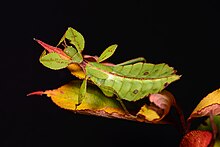
The family Phylliidae contains the extant true leaf insects or walking leaves, which include some of the most remarkably camouflaged leaf mimics (mimesis) in the entire animal kingdom. They occur from South Asia through Southeast Asia to Australia. Earlier sources treat Phylliidae as a much larger taxon, containing genera in what are presently considered to be several different families.

Phobaeticus is a genus of Asian stick insects comprising over 25 species. The genus includes some of the world's longest insects.

Phyllium is the largest and most widespread genus of leaf insects in the family Phylliidae (Phasmatodea). They can be found in Sundaland, Philippine Islands, Wallacea, and Australasia.

Pulchriphyllium giganteum, commonly known as the Giant Malaysian Leaf insect, is a species of leaf insects described from Malaysia by Hausleithner in 1984 and placed in the genus Pulchriphyllium since 2021. Pulchriphyllium giganteum is the largest species belonging to the genus Pulchriphyllium reaching 105 mm in size. They are found most abundantly in the west Malaysian tropics. The females typically have large elytra that lie edge to edge on the abdomen and tend to lack hind wings making them usually flightless. Males have small elytra and sometimes transparent non-leaflike functional hind wings. Pulchriphyllium giganteum found in the wild tend to be mostly females and the first male of this species was not found until 1994. In captivity, the species has primarily been observed to reproduce through parthenogenesis meaning the females are asexual. The primary reproductive pattern in the wild is unknown. Eggs tend to be brown or black and glossy and resemble seeds. They hatch around 6 months after breeding. Newly hatched young nymphs tend to be wingless and brown or reddish in color. They develop their green color after feeding on leaves. Both the adult and larval stages are phytophagous meaning they feed on plants. The main plant food sources for this species are oak and bramble tree leaves.
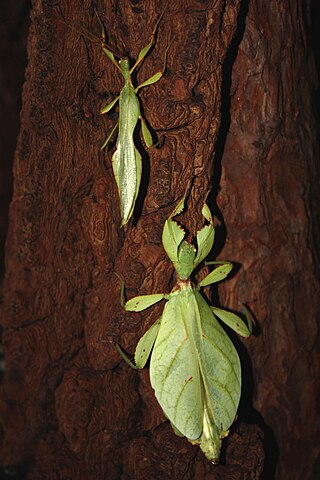
Phyllium jacobsoni is a species of leaf insect belonging to the family Phylliidae. Its recorded distribution is Java and no subspecies are listed in the Catalogue of Life.

Cryptophyllium westwoodii is a species of leaf insect in the family Phylliidae. It is distributed from southern China, the Andaman islands, Myanmar, Indo-China, Sumatra and the Riouw Archipelago.

The Clitumninae are a sub-family of stick insects in the family Phasmatidae found in Asia. The type genus Clitumnus is now considered a synonym of Ramulus.

Phyllium bilobatum is a species of leaf insect in the family Phylliidae. It is found in the Philippines and Malaysia. This species was first described in 1843 by the English zoologist George Robert Gray, who gave it the name Phyllium bilobatum. It has been assigned to the subgenus Phyllium, which is to be distinguished from the second subgenus Pulchriphyllium, within the genus Phyllium. The holotype is a female from the Philippines, which is kept in the Natural History Museum, London where Gray worked cataloguing insects.
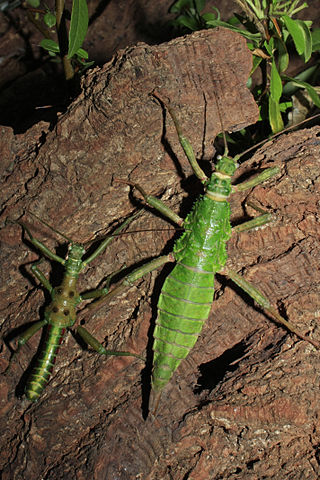
Mearnsiana is a genus of stick insects, which is native to the Philippine islands Mindanao, Leyte and Dinagat.
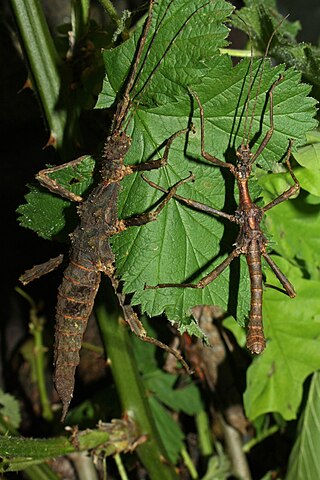
Trachyaretaon is a genus of stick insects native to the Philippines.

Theramenes is a genus of medium-sized stick insects in the tribe Obrimini, which is native to the Philippines and to the Indonesian Talaud Islands.

Orestes japonicus, a stick insect, is a representative of the genus Orestes.

Orestes shirakii is a species of stick insects native to Taiwan.

Trachyaretaon carmelae is a species of stick insects. It is one of the largest in the subfamily Obriminae.

Phyllium mabantai is a species of leaf insect in the family Phylliidae. It is endemic to the Philippines.
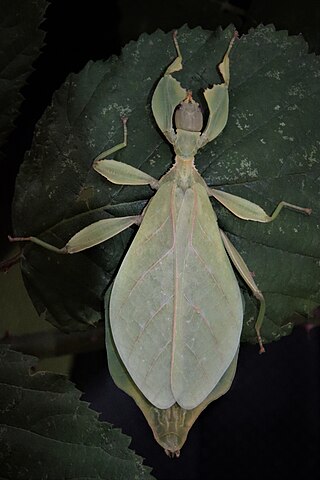
Phyllium gantungense is a species of insect in the family Phylliidae. It is endemic to the Philippines.

Phyllium ericoriai is a species of leaf insect in the family Phylliidae.
Cnipsomorpha is a genus of Asian stick insects in the tribe Medaurini, erected by Hennemann, Conle, Zhang and Liu in 2008. Species have been recorded from: southern China and Vietnam.

Frank H. Hennemann is a German entomologist and taxonomist who works in the field of biodiversity research on the systematics and biogeography of stick insects (Phasmatodea).
